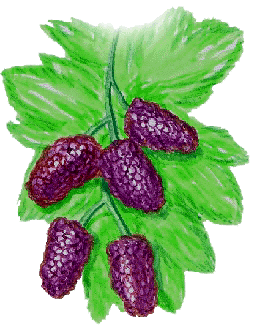...Best of Sicily presents... Best of Sicily Magazine. ... Dedicated to Sicilian art, culture, history, people, places and all things Sicilian. |
by Roberta Gangi | ||
Magazine Index Best of Sicily Arts & Culture Fashion Food & Wine History & Society About Us Travel Faqs Contact Map of Sicily |
This is hardly the only Biblical reference to mulberries, or the earliest. Kings and farmers alike favored mulberries; Charlemagne enjoyed the trees in his private garden, planted circa 812. Pliny, Ovid and Virgil wrote about the mulberry, which was raised on farms throughout the Italian peninsula, but while the Romans associated silk with its leaves, they may not have understood that silk worms actually produced the substance. It was known by Greek chroniclers that the mulberry was a Persian fruit. (In truth, the Romans themselves were responsible for the introduiction of a number of plant species across Europe.) Though the ancient Greeks or Phoenicians may have introduced the tree in Sicily, neither they nor the Romans undertook particularly widespread cultivation of the trees here. That distinction belongs to the Saracens (Moors). In their slow but steady migration westward, these Semitic peoples brought with them various plants, such as lemons and oranges, to cultivate in their new land. These, too, were known to the Romans, but were never grown in Italy on so large a scale. The fruit, however, was only a secondary reason for planting the mulberry trees in Sicily. The main purpose was the leaves of the hardy mulberry tree, favored by silkworms. During the Arab era and into the Norman period, Sicily became a center of silk production and silk weaving. Into the reign of Frederick II, royal robes were woven of Sicilian silk, and the fabric was exported across western Europe as far away as Scotland and Denmark. During the same period, the Moors popularized cultivation of the mulberry in their other major European dominion, Spain. Morus nigra, the so-called "Black Persian Mulberry," the most common black mulberry, probably originated in China and has been cultivated in China, central Asia, India and Japan from a very early date. The tree is resilient, requiring less water than many other berry-producing plants. Not only are its berries delicious and therapeutic, and its leaves useful in silkmaking as well as animal feed, but the tree itself is a beautiful ornamental whose wood is artistically useful in carving. There is little doubt that it figured in the landscape of the extensive royal parks of Sicily's Norman and Swabian kings. Today, there are precious few mulberry trees in Sicily, and the prices of the springtime fruit are expensive, but in the Middle Ages there were entire plantations of black and white mulberries, the latter preferred for silk production. It is possible that Chinese silk production dates from around 3500 BC (BCE). In Egypt, silk was being made circa 1100 BC. Sericulture is almost a science in itself, but its techniques are universal. Spinning of silk fibers is still, for the most part, a traditional trade unaided by modern machinery. The Sicilian silk industry is a thing of the past. Nowadays, most of Italy's silk comes from the communities around the northern city of Como, where the white mulberry is raised for this purpose. Black mulberry trees, which are typically bushy and grow to a height of around ten meters (about thirty feet), have been known to live, and bear fruit, for centuries. (A living mulberry tree in Brentford, England, is believed to have been planted, from Persian stock, in 1548.) Botanically speaking, the sweet, juicy mulberry fruit is not actually a berry, but a collective fruit that grows to about 2.5 centimeters (about an inch) in length. A number of hybrids exist, but the three basic varieties were the American red mulberry (morus rubra), the white mulberry (morus alba) of China, and the black mulberry. Related species are the Korean mulberry (morus australis) and Himalayan mulberry (morus laevigata). Moro was the traditional Italian word for the mulberry tree; in modern Italian gelso is preferred. About the Author: Roberta Gangi has written numerous articles and one book dealing with Italian cultural and culinary history, and several food and wine articles for Best of Sicily Magazine. | |
Top of Page |
 "If you have faith as small as a mustard seed, you can say to this mulberry tree, 'Be uprooted and planted in the sea,' and it will obey you."
"If you have faith as small as a mustard seed, you can say to this mulberry tree, 'Be uprooted and planted in the sea,' and it will obey you."